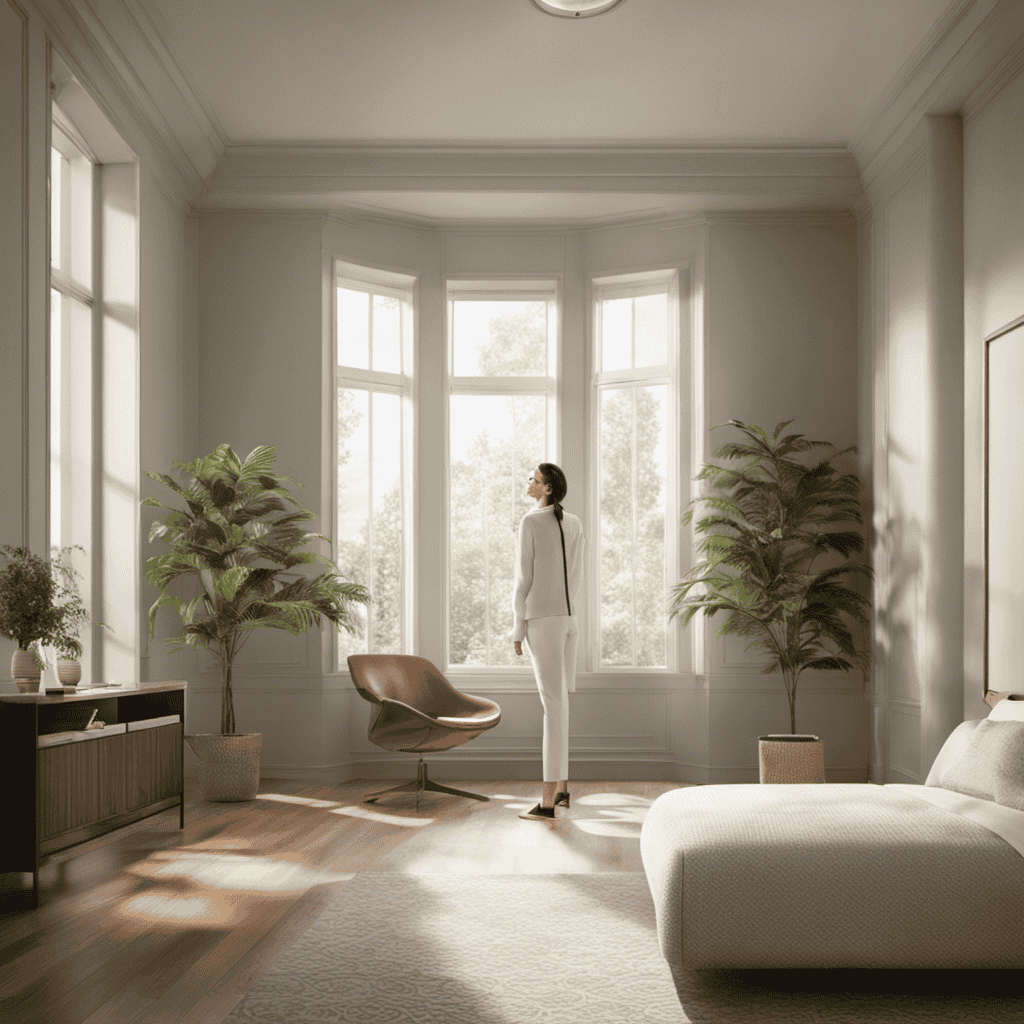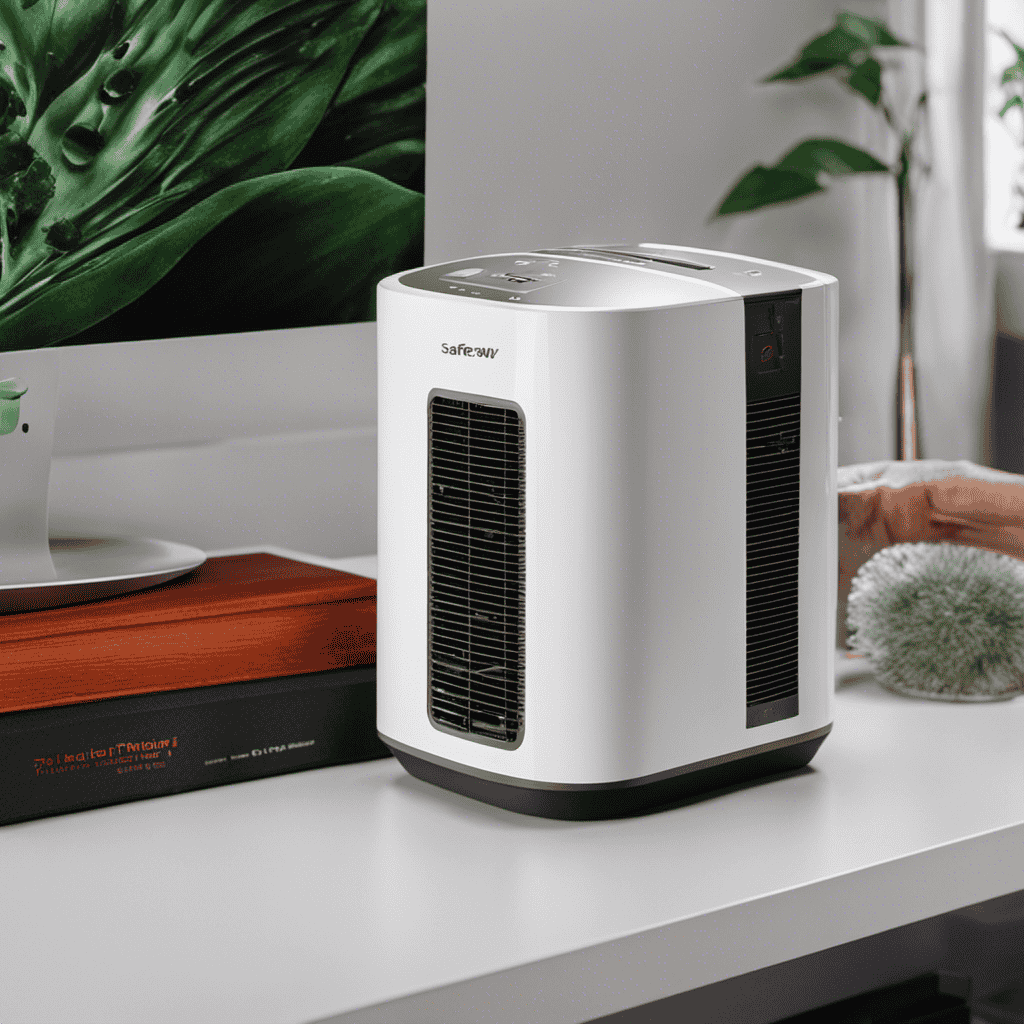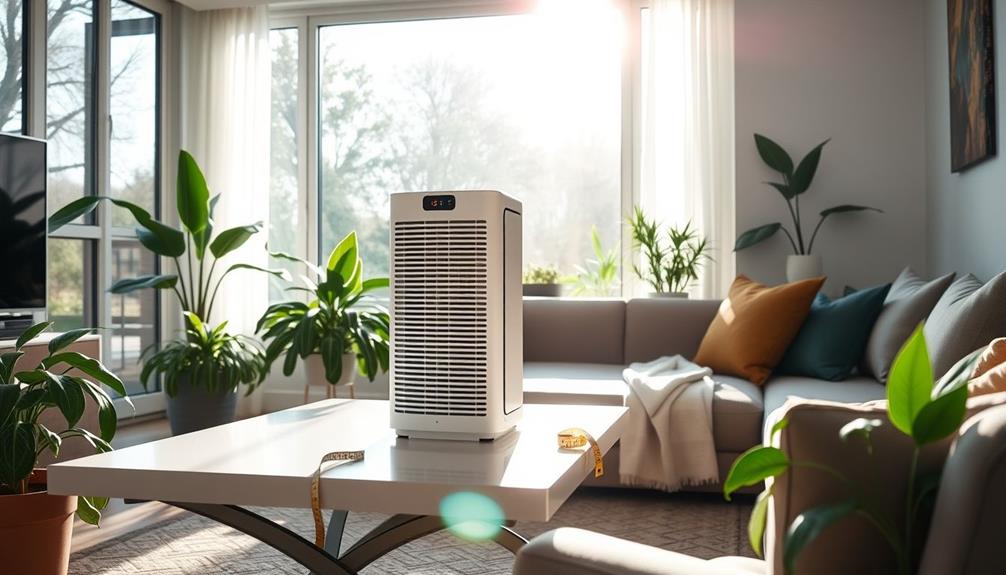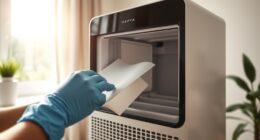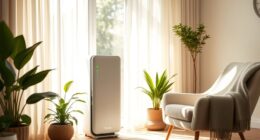As someone who specializes in air quality, I recognize how crucial it is to position your air purifier correctly. However, the question remains: where is the ideal location for it?
In this comprehensive guide, I’ll provide you with expert advice on the ideal locations for your air purifier throughout your home. From the bedroom for better sleep to the living room for cleaner air while you relax, we’ll explore the benefits of strategic placement.
So let’s dive in and discover where to position your air purifier for optimal results.
Key Takeaways
- Placing air purifiers in different rooms can improve air quality, reduce allergens, and eliminate unpleasant odors.
- Ideal placement of air purifiers includes placing them near the bed in the bedroom, near a window in the living room, and in the kitchen to remove cooking odors.
- Air purifiers should also be placed in the nursery/child’s room, basement, garage, bathroom, study/library, pet areas, and high-traffic areas to ensure clean air and reduce pollutants.
- Different types of air purifiers, such as HEPA purifiers, activated carbon purifiers, UV-C purifiers, and ionizer purifiers, offer various features to address specific air quality concerns.
Benefits of Placing Your Air Purifier in the Bedroom
You’ll experience improved air quality and better sleep by placing your air purifier in the bedroom. When it comes to our health, a good night’s sleep is essential.
By removing allergens, pollutants, and other airborne particles from the air in your bedroom, an air purifier can help create a cleaner and healthier sleep environment. Improved air quality means you can breathe in cleaner air, which can have a positive impact on your respiratory health. This is especially important for individuals with allergies, asthma, or other respiratory conditions.
The Ideal Location for an Air Purifier in the Living Room
The ideal spot for an air purifier in the living room is near a window or in a corner. Placing it in these locations allows for optimal air circulation and ensures that the purifier can effectively remove pollutants from the room. Here are some key reasons why this placement is beneficial:
- By placing the air purifier near a window, you can take advantage of natural ventilation and allow fresh air to flow into the room.
- Placing it in a corner maximizes its coverage area and ensures that it can effectively clean the air in the entire living room.
- The purifier can capture airborne particles, such as dust, pollen, and pet dander, before they settle on furniture and surfaces.
- It can help eliminate unpleasant odors, such as cooking smells or smoke, improving the overall air quality in the living room.
- By removing allergens and pollutants from the air, the purifier creates a healthier environment, especially for those with respiratory conditions or allergies.
Overall, strategic placement of an air purifier in the living room can significantly improve indoor air quality and create a more comfortable and pleasant space for everyone.
Is the Kitchen a Suitable Spot for Your Air Purifier
Placing an air purifier in the kitchen can help improve air quality by removing cooking odors and airborne particles. The kitchen is often a hub of activity, with various cooking processes releasing pollutants into the air. These pollutants, known as kitchen air pollution, can include smoke, grease particles, and volatile organic compounds (VOCs), all of which can negatively impact indoor air quality.
Cooking odors can be particularly troublesome, lingering long after the meal has been enjoyed. An air purifier equipped with a carbon filter can effectively eliminate these odors, leaving your kitchen smelling fresh and clean.
Additionally, the air purifier can capture and trap airborne particles, such as dust, pet dander, and pollen, further improving the overall air quality in your kitchen.
Placing an Air Purifier in the Home Office for Improved Air Quality
Setting up an air purifier in your home office can greatly enhance the air quality, making it a healthier and more productive environment. Here are some benefits of having an air purifier in your home office:
-
It filters out allergens, such as dust, pollen, and pet dander, preventing them from circulating in the air and reducing the risk of allergies and respiratory issues.
-
The purifier traps and removes harmful pollutants, like volatile organic compounds (VOCs) and formaldehyde, which can be released from furniture, carpets, and office equipment.
-
It helps eliminate unpleasant odors, such as food smells or chemical odors, creating a more pleasant and inviting workspace.
-
An air purifier can reduce the presence of airborne viruses and bacteria, reducing the chances of getting sick and improving overall wellness.
-
It can provide a white noise effect, creating a peaceful and calming atmosphere that can enhance focus and concentration.
The Importance of Having an Air Purifier in the Nursery or Child’s Room
Having an air purifier in the nursery or child’s room can significantly improve the air quality and create a healthier environment for your little one. The benefits of air purifiers in the nursery cannot be overstated, especially when it comes to the importance of clean air for children’s health.
Air purifiers help to remove common indoor pollutants such as dust, pet dander, pollen, and mold spores, which can trigger allergies and asthma symptoms in children. By reducing these airborne particles, air purifiers can help children breathe easier and sleep better at night.
Additionally, air purifiers can also help to eliminate unpleasant odors, creating a fresh and clean atmosphere in the nursery. Ensuring that your child breathes clean and pure air is essential for their overall well-being and development.
Can an Air Purifier in the Dining Room Enhance Your Indoor Air Quality
Using an air purifier in the dining room can greatly improve the indoor air quality, making it a healthier environment for everyone. Air purifiers are highly effective at removing airborne pollutants, such as dust, pollen, pet dander, and even cooking odors. By placing an air purifier in your dining room, you can ensure that the air you breathe while enjoying meals is clean and fresh.
Here are five ways an air purifier can enhance your dining room air quality:
- Capturing and trapping allergens and pollutants.
- Filtering out cooking smells and odors.
- Reducing the presence of airborne bacteria and viruses.
- Removing airborne particles that may trigger respiratory issues.
- Enhancing the overall comfort and cleanliness of the dining area.
Investing in an air purifier for your dining room is a wise choice that can greatly improve the air quality and create a healthier and more enjoyable dining experience for you and your family.
Should You Consider Placing an Air Purifier in the Basement
As an expert in indoor air quality, I would like to discuss the importance of considering placing an air purifier in the basement.
Basement air quality can often be compromised due to poor ventilation and the presence of moisture, which can lead to the growth of mold and mildew.
By placing an air purifier in the basement, you can effectively remove airborne pollutants and allergens, improving the overall air quality in your home.
However, if you don’t have a basement or prefer not to place an air purifier there, there are alternative options such as using multiple purifiers throughout your home or focusing on improving ventilation in other areas.
Basement Air Quality
To improve the air quality in your basement, you should consider placing the air purifier in a central location. This will ensure that the purifier can effectively circulate and filter the air throughout the entire space.
When it comes to basement air quality, there are a few key factors to consider:
-
Moisture: Basements are prone to high humidity levels, which can lead to mold and mildew growth. An air purifier can help remove excess moisture from the air, reducing the risk of these issues.
-
Odors: Basements often have a musty smell due to poor ventilation. An air purifier with activated carbon filters can effectively eliminate odors, making the space more pleasant.
-
Dust and allergens: Basements can accumulate dust, pet dander, and other allergens. A high-quality air purifier can capture and remove these particles, improving indoor air quality.
-
Radon gas: Radon gas is a common issue in basements. While an air purifier alone cannot eliminate radon, it can help reduce its concentration in the air.
-
VOCs: Volatile organic compounds (VOCs) can be released from various sources in the basement, such as cleaning products or paints. An air purifier with a HEPA filter can effectively trap these harmful chemicals.
Benefits of Basement Placement
Placing the air purifier in the basement can help improve air quality throughout the entire space. The basement is often a neglected area when it comes to air purification, but it is actually an ideal location for an air purifier. Not only does it help filter out any pollutants or allergens present in the basement, but it also helps to circulate clean air to the upper levels of the house. This is especially beneficial if you spend a lot of time in the basement or if it is used as a living space.
When considering the placement of your air purifier, it’s important to explore alternatives to the basement as well. Here is a table to help you understand the optimal placement options for your air purifier:
| Placement Option | Benefits |
|---|---|
| Basement | Filters pollutants and improves air quality |
| Living Room | Enhances air quality in the most frequently used area |
| Bedroom | Provides clean air for better sleep and respiratory health |
Alternatives to Basement?
Considering other options for the placement of your air purifier, the living room and bedroom are alternative locations that can enhance air quality in frequently used areas. When deciding between these two options, it’s important to consider their effectiveness in comparison to each other.
Here are some factors to consider when choosing the best alternative location for your air purifier:
-
Living Room: This central area of your home is often the hub of activity, making it an ideal location for an air purifier. It can help remove pollutants from cooking, smoking, and everyday activities.
-
Bedroom: By placing an air purifier in your bedroom, you can ensure that you’re breathing clean air while you sleep. This can be particularly beneficial for individuals with allergies or respiratory conditions.
Overall, both the living room and bedroom provide alternative locations for your air purifier that can effectively enhance air quality in frequently used areas. Consider your specific needs and preferences to determine which option is best for you.
The Benefits and Considerations of Having an Air Purifier in the Garage
Having an air purifier in the garage can greatly improve the air quality and reduce the presence of dust and pollutants.
When considering the placement of an air purifier, the garage is often overlooked. However, it is important to recognize the benefits of having an air purifier in this space.
Garage air quality can be compromised by various factors such as fumes from vehicles, chemicals, and dust from outdoor activities. By placing an air purifier in the garage, you can effectively filter out these contaminants, creating a healthier environment for both you and your family.
Additionally, having a garage air purifier can help prevent the spread of pollutants into the rest of your home, ensuring that the air you breathe indoors is clean and fresh.
Is It Necessary to Have an Air Purifier in the Bathroom
As an expert in air quality, I would like to discuss the importance of having an air purifier in the bathroom.
The bathroom is a space where moisture and odors can accumulate, leading to poor air quality.
By using an air purifier, you can effectively remove impurities, allergens, and unpleasant odors, ensuring a healthier and more comfortable environment.
When it comes to placement, it is recommended to position the air purifier in a location where it can efficiently circulate the air, such as near the toilet or shower area, to effectively capture and filter any pollutants present.
Bathroom Air Quality
If you want to improve your bathroom air quality, you should consider placing your air purifier near the toilet. The toilet is one of the main sources of odors and bacteria in the bathroom, so having an air purifier in close proximity can help eliminate these issues.
Here are some alternative locations for your air purifier in the bathroom:
-
On the bathroom countertop: This is a convenient and accessible spot for an air purifier, ensuring that it can efficiently clean the air in the entire bathroom.
-
Wall-mounted: Installing the air purifier on the wall not only saves space but also allows for better circulation of clean air throughout the room.
-
Near the shower: Placing the air purifier near the shower can help remove excess moisture and prevent the growth of mold and mildew.
-
Above the toilet: Mounting the air purifier above the toilet can target odor and bacteria at the source, ensuring a fresh-smelling bathroom.
-
Near the bathroom entrance: Positioning the air purifier near the entrance can help capture any pollutants or odors before they spread throughout the bathroom.
Benefits of Purifier
Placing an air purifier in strategic locations can greatly enhance bathroom air quality and promote a healthier environment. When it comes to alternative purifiers, there are a few options to consider.
One popular choice is an activated carbon purifier, which effectively removes odors and harmful gases from the air. Another option is a HEPA purifier, which can capture tiny particles like dust, pollen, and pet dander.
Regardless of the type of purifier you choose, regular maintenance is essential to ensure optimal performance. Here are a few maintenance tips to keep in mind.
First, regularly clean or replace the filters according to the manufacturer’s instructions. Second, keep the purifier away from water sources to prevent damage. Finally, consider using a timer or smart features to control the purifier’s operation and save energy.
Placement Recommendations?
To maximize the effectiveness of your purifier, it’s important to consider the recommended placement locations. Where you put your air purifier can greatly impact its ability to clean the air in your home. Here are some key recommendations:
-
Bedroom placement: Placing your purifier in the bedroom ensures that you breathe clean air while you sleep. This is especially important for those with allergies or respiratory conditions.
-
Living room location: The living room is often a central area where family members spend a significant amount of time. Placing the purifier here can help remove pollutants and improve overall air quality in the shared space.
Improving Air Quality in Your Home Gym With an Air Purifier
You can greatly improve the air quality in your home gym by using an air purifier. As an expert in air purification, I highly recommend investing in a high-quality air purifier specifically designed for fitness spaces. These purifiers are equipped with advanced features to effectively remove airborne pollutants and odors, creating a clean and fresh environment for your workouts.
To help you understand the benefits of an air purifier for your home gym, I have provided a table comparing the different types of purifiers and their features:
| Type of Air Purifier | Key Features |
|---|---|
| HEPA Purifier | Filters out 99.97% of particles as small as 0.3 microns, including dust, pollen, and pet dander. |
| Activated Carbon Purifier | Removes odors, smoke, and volatile organic compounds (VOCs) from the air. |
| UV-C Purifier | Utilizes ultraviolet light to kill bacteria, viruses, and mold spores. |
| Ionizer Purifier | Releases negative ions that attach to airborne particles, making them heavier and easier to filter out. |
The Role of an Air Purifier in the Laundry Room
When it comes to optimizing the effectiveness of an air purifier in your laundry room, proper placement is key. Placing the air purifier in a central location, away from obstructions and close to the source of pollutants, will ensure that it can effectively clean the air in the room.
In addition to improving air quality, an air purifier in the laundry room offers a range of benefits. These include reducing odors, eliminating allergens, and removing harmful particles.
To ensure the longevity of your air purifier and maintain its optimal performance, regular maintenance is essential. This includes cleaning or replacing filters.
Optimal Placement for Effectiveness
For optimal effectiveness, it’s important to place your air purifier in an area with good air circulation. This ensures that the purifier can effectively capture and remove airborne pollutants from the surrounding environment.
Here are some tips to help you choose the right spot for your air purifier:
-
Place it in a central location: This allows for even distribution of clean air throughout the room.
-
Avoid placing it near obstacles: Keep the purifier away from furniture, curtains, or other objects that may obstruct airflow.
-
Keep it away from direct sunlight: Sunlight can cause the purifier’s filters to degrade faster, so it’s best to keep it in a shaded area.
-
Consider the size of the room: Choose an air purifier that is suitable for the size of the room to ensure optimal performance.
-
Regular maintenance is key: Clean or replace the filters as recommended by the manufacturer to maintain the purifier’s effectiveness.
Following these tips will help you maximize the efficiency of your air purifier and enjoy cleaner, healthier air in your home.
Benefits of Clean Air
To fully appreciate the benefits of clean air, it’s important to understand how it can improve your overall health and well-being. Clean air plays a vital role in improving productivity and reducing respiratory issues. When the air you breathe is free from pollutants and allergens, your respiratory system functions optimally, allowing for better oxygen flow to your brain and muscles. This leads to increased focus, alertness, and productivity. Additionally, clean air helps reduce the risk of respiratory issues such as asthma and allergies, providing relief to those who suffer from these conditions. To showcase the benefits of clean air, here is a table highlighting the positive impacts it can have on your health and well-being:
| Benefits of Clean Air |
|---|
| Improved productivity |
| Reduced respiratory issues |
| Enhanced focus and alertness |
| Decreased risk of asthma |
| Relief from allergies |
Proper Maintenance for Longevity
Now that we’ve discussed the benefits of clean air, let’s move on to the proper maintenance of your air purifier to ensure its longevity. Taking care of your air purifier is crucial in order to maximize its effectiveness and keep your indoor air quality at its best.
Here are some important maintenance tips:
- Regularly clean or replace the filters to prevent clogging and maintain optimal airflow.
- Keep the air purifier in a well-ventilated area to avoid overheating.
- Vacuum the surrounding area to minimize dust accumulation and improve air circulation.
- Consider alternative locations for your air purifier, such as the basement, to target specific air quality concerns.
- Don’t forget about the bathroom! Install a specialized air purifier to combat mold, mildew, and other pollutants commonly found in this high-moisture area.
Enhancing Your Indoor Air Quality With an Air Purifier in the Study or Library
Placing an air purifier in your study or library can greatly improve your indoor air quality. As an expert in home office air quality, I highly recommend investing in an air purifier for these spaces. Not only will it remove harmful pollutants and allergens from the air, but it will also create a healthier and more productive environment for work or study.
To give you a better understanding of the benefits, here is a table showcasing the effectiveness of an air purifier in a study or library setting:
| Benefit | Description |
|---|---|
| Removes Dust | An air purifier captures and filters out dust particles, reducing the amount of dust that settles on surfaces and books. |
| Eliminates Odors | Whether it’s the smell of books or lingering food odors, an air purifier can neutralize and eliminate unpleasant odors. |
| Reduces Allergens | By capturing and trapping allergens like pollen and pet dander, an air purifier can provide relief to allergy sufferers. |
In addition, if you have a nursery in your home, incorporating an air purifier can be even more beneficial. It will ensure the air your baby breathes is clean and free from harmful pollutants.
Overall, investing in an air purifier for your study, library, or nursery is a wise decision for improving indoor air quality and creating a healthier environment.
Can an Air Purifier in the Pet Area Help With Allergies and Odors
As an expert in indoor air quality, I can confidently say that having an air purifier in the pet area can greatly help with allergies and odors.
Pet dander and fur can trigger allergies in many people, and an air purifier with a HEPA filter can effectively remove these allergens from the air.
Additionally, pet odors can be a persistent problem, but an air purifier equipped with activated carbon filters can help eliminate these odors, leaving your home smelling fresh and clean.
Pet Area Air Purifier
You’ll want to place your pet area air purifier in a location where your furry friend spends the most time. This will ensure maximum effectiveness in maintaining a clean and healthy environment for both you and your pet.
When choosing the location for your air purifier, consider the following factors:
-
Proximity: Place the air purifier as close as possible to your pet’s favorite hangout spots, such as their bed or litter box.
-
Height: Position the purifier at a height that allows for optimal air circulation, avoiding obstructions like furniture or curtains.
-
Size: Select an air purifier that is appropriate for the size of your pet area to effectively filter the air and remove pet dander and odors.
-
Noise level: Consider the noise level of the purifier, as some pets may be sensitive to loud sounds.
-
Maintenance: Ensure easy access for filter changes and maintenance to keep your pet area air purifier running smoothly.
Now that you know where to place your pet area air purifier, let’s explore how it can help with allergies and odors.
Allergies and Odors?
To effectively address allergies and odors, consider the size and features of the pet area air purifier. Pet dander and odors can be major triggers for allergies, so it’s important to choose a purifier that is equipped to handle these issues. Look for a model with a HEPA filter, as this will effectively capture pet allergens and other indoor pollutants. Additionally, consider the size of the area you need to purify. A larger pet area may require a more powerful purifier to effectively clean the air. Don’t forget to also consider the noise level and maintenance requirements of the purifier. By selecting the right pet area air purifier, you can create a healthier and more comfortable environment for both you and your furry friend.
| Feature | Importance | Example |
|---|---|---|
| HEPA Filter | Essential | True HEPA filter captures 99.97% of allergens |
| Coverage Area | Important | Covers up to 350 sq. ft. |
| Noise Level | Moderate | Operates at 40 dB on low setting |
The Benefits of Having an Air Purifier in High-Traffic Areas
Place your air purifier in high-traffic areas to enjoy the benefits it provides. Not only does this ensure maximum air quality improvement, but it also offers numerous health benefits.
Here are five reasons why having an air purifier in high-traffic areas is beneficial:
-
Reduced allergens: The air purifier captures allergens like pollen, dust mites, and pet dander, making the air cleaner and reducing allergy symptoms.
-
Odor elimination: Whether it’s lingering cooking smells or the scent of pets, the purifier effectively removes odors, leaving the air fresh and clean.
-
Improved respiratory health: By filtering out pollutants and toxins, the air purifier helps to prevent respiratory issues and keeps your lungs healthy.
-
Enhanced sleep quality: With cleaner, purer air, you’ll breathe easier, leading to a more restful night’s sleep.
-
Increased productivity: Breathing clean air can boost focus and concentration, helping you be more productive in high-traffic areas.
With these benefits, placing an air purifier in high-traffic areas is a smart choice for maintaining a healthy environment.
Should You Consider Placing an Air Purifier in the Hallway?
Consider placing an air purifier in the hallway to ensure that the air you breathe in that high-traffic area is clean and free from pollutants. The hallway is often overlooked when it comes to air quality, but it is a crucial space that connects different rooms in your home. By placing an air purifier in the hallway, you can effectively filter out harmful particles and improve the overall air quality in your living environment.
Here are the pluses and minuses of placing an air purifier in the hallway:
| Pluses | Minuses |
|---|---|
| Removes pollutants such as dust, allergens, and odors | May take up space in a narrow hallway |
| Improves air circulation and reduces stuffiness | Requires regular maintenance and filter replacements |
| Enhances the overall air quality in your home | May produce some noise depending on the purifier model |
| Provides cleaner air for you and your family | Initial cost of purchasing an air purifier |
Considering the potential benefits, it is worth investing in an air purifier for your hallway to maintain optimal air quality and promote a healthier living environment.
Frequently Asked Questions
Can an Air Purifier in the Bedroom Help With Sleep Quality?
Yes, an air purifier in the bedroom can help improve sleep quality. It filters out pollutants and allergens, creating a cleaner and healthier environment. This can lead to better breathing and reduced nighttime disturbances, resulting in a more restful sleep.
How Often Should I Clean or Replace the Filters in My Air Purifier?
I clean or replace the filters in my air purifier every 3 to 6 months, depending on usage. Regular cleaning frequency is important to maintain the effectiveness and efficiency of the purifier.
Can an Air Purifier Remove Pet Dander and Allergens From the Living Room?
An air purifier for pet owners can effectively remove pet dander and allergens from the living room. It provides numerous benefits for allergy sufferers, improving indoor air quality and reducing symptoms.
Are There Any Specific Features or Technologies to Look for When Choosing an Air Purifier for the Nursery?
When it comes to choosing an air purifier for the nursery, it’s important to look for specific features and technologies that can ensure air purifier maintenance and provide the maximum benefits for babies.
Can an Air Purifier Effectively Remove Cooking Odors From the Kitchen?
An air purifier can effectively remove cooking odors from the kitchen. By filtering out the particles and pollutants that cause these odors, it helps to improve the air quality and create a fresher environment in your kitchen.
Conclusion
In conclusion, placing an air purifier in various areas of your home can greatly improve the quality of the air you breathe. These devices are effective in removing allergens, odors, and pollutants. From the bedroom to the living room, kitchen, and even high-traffic areas, air purifiers act as a breath of fresh air. They ensure you and your family can enjoy a healthier and more comfortable living environment.
So, don’t hesitate to find the perfect spot for your air purifier. Let it work its magic, clearing the air and bringing a breath of fresh air into your home.



